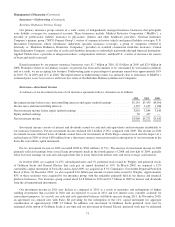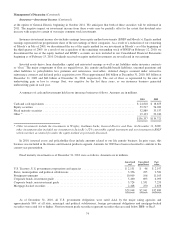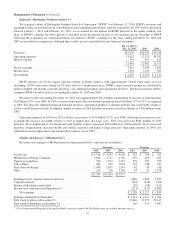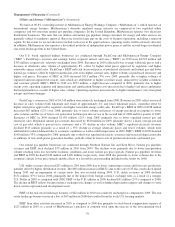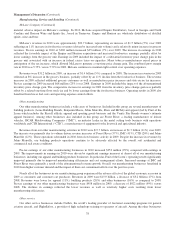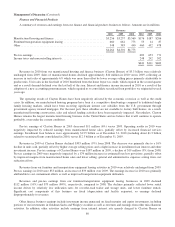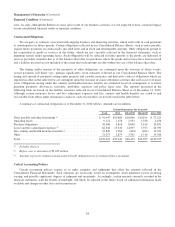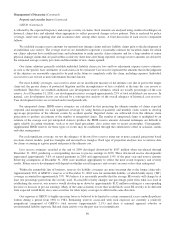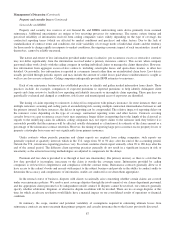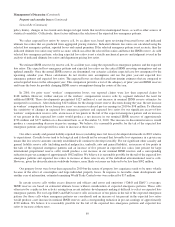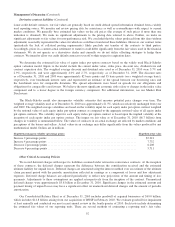Berkshire Hathaway 2010 Annual Report Download - page 84
Download and view the complete annual report
Please find page 84 of the 2010 Berkshire Hathaway annual report below. You can navigate through the pages in the report by either clicking on the pages listed below, or by using the keyword search tool below to find specific information within the annual report.Management’s Discussion (Continued)
Investment and Derivative Gains/Losses (Continued)
Although we expect that these businesses will continue to remain profitable and that the market prices for these securities will
eventually exceed our original cost, we could not establish sufficient objective evidence as to the timing or amount of the future
recovery in market prices. We also recorded other-than-temporary impairment losses of about $1.0 billion on certain debt
instruments where, after evaluation, we concluded that we would likely not receive all contractual cash flows when due.
Other-than-temporary impairment losses in 2009 predominantly relate to a loss with respect to our investment in
ConocoPhillips common stock. The market price of ConocoPhillips shares declined sharply over the last half of 2008. In 2009,
we sold over half of the ConocoPhillips position we held at the end of 2008. Sales in 2009 were in anticipation of other
investment opportunities, to increase overall liquidity and to realize capital losses that were carried back to prior years for
income tax purposes. We continue to hold over 29 million shares of ConocoPhillips and its market price as of December 31,
2010 was about 75% over its market price at the time we recorded the aforementioned other-than-temporary impairment loss.
None of the subsequent recovery in the market price of ConocoPhillips currently held is reflected in our net earnings but it is
reflected in accumulated other comprehensive income.
Other-than-temporary impairment losses recorded in 2008 were primarily related to investments in twelve equity securities.
The unrealized losses in these securities generally ranged from 40% to 90% of cost. After reviewing these investments, we
concluded that there was considerable uncertainty in the business prospects of these companies and thus uncertainty on the
recoverability of the cost of the security.
Derivative gains/losses primarily represent the changes in fair value of our credit default and equity index put option
contracts. Changes in the fair values of these contracts are reflected in earnings and can be significant, reflecting the volatility of
equity and credit markets. We have not actively traded into and out of credit default and equity index put option contracts.
Under many of the contracts, no settlements will occur until the contract expiration dates, many years from now. We reported
pre-tax gains on our credit default contracts of $250 million in 2010, $789 million in 2009 and pre-tax losses of $1.8 billion in
2008. These gains and losses reflect the changes in the fair values of these contracts. The fair values of our credit default
contracts are impacted by changes in credit default spreads, which have been volatile from period to period. The gains in 2010
reflected the overall narrowing of credit default spreads for corporate issuers and were somewhat offset by losses due to the
widening of spreads for municipalities, particularly in the fourth quarter. There were no credit loss events on our contracts in
2010. The gains and losses from our credit default contracts in 2009 and 2008 derived primarily from changes in the fair value
of our liabilities due to a significant widening of credit default spreads of corporate issuers in 2008 and the narrowing of spreads
for corporate issuers in 2009. There were several credit loss events in the second half of 2008 and the beginning of 2009,
primarily related to contracts involving non-investment grade (or high-yield) corporate issuers and during 2009 we paid losses
of about $1.9 billion.
In 2010 and 2009, gains on equity index put option contracts were $172 million and $2.7 billion, respectively compared to
losses of $5.0 billion in 2008. In the fourth quarter of 2010, we settled certain equity index put option contracts early at the
request of the counterparty. The net gain in 2010 arising from these settled contracts was $561 million, which is represented by
the difference between the recorded fair values of the contracts at December 31, 2009 and the settlement payment amounts.
Otherwise, we recognized pre-tax losses of $389 million under our remaining equity index put option contracts reflecting
generally lower interest rate assumptions and the effect of foreign currency exchange rate changes. The derivative contract gains
in 2009 reflected increases in the underlying equity indexes ranging from approximately 19% to 23%, partially offset by the
impact of a weaker U.S. Dollar on non-U.S. contracts and lower interest rates. These factors combined to produce a decrease in
our estimated liabilities. The losses in 2008 reflected declines of between 30% and 45% in underlying equity indexes. Our
ultimate payment obligations, if any, under our remaining equity index put option contracts will be determined as of the contract
expiration dates, which begin in 2018. Except for the early settlements referred to previously, there have been no other cash
settlements related to these contracts.
Financial Condition
Our balance sheet continues to reflect significant liquidity and a strong capital base. Our consolidated shareholders’ equity
at December 31, 2010 was $157.3 billion, an increase of $26.2 billion from December 31, 2009. The increase in our
shareholders’ equity included approximately $10.6 billion related to the issuance of Berkshire common stock in connection with
the BNSF acquisition.
82



